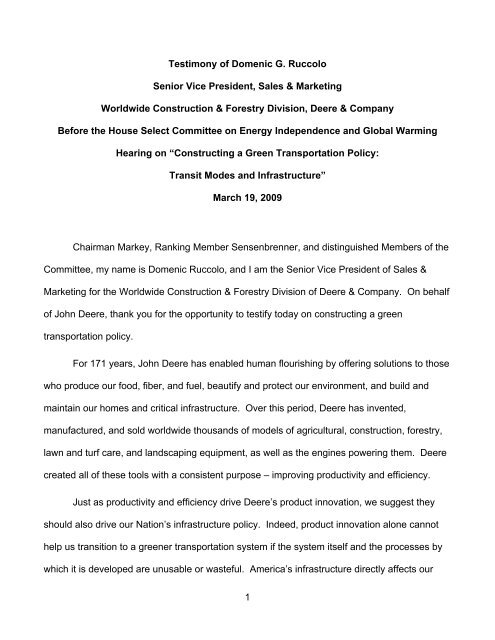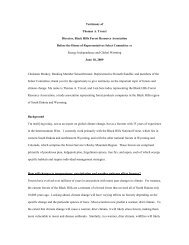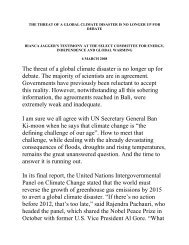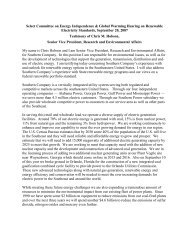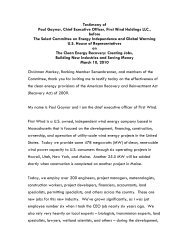Domenic G. Ruccolo - The Select Committee for Energy ...
Domenic G. Ruccolo - The Select Committee for Energy ...
Domenic G. Ruccolo - The Select Committee for Energy ...
You also want an ePaper? Increase the reach of your titles
YUMPU automatically turns print PDFs into web optimized ePapers that Google loves.
Testimony of <strong>Domenic</strong> G. <strong>Ruccolo</strong><br />
Senior Vice President, Sales & Marketing<br />
Worldwide Construction & Forestry Division, Deere & Company<br />
Be<strong>for</strong>e the House <strong>Select</strong> <strong>Committee</strong> on <strong>Energy</strong> Independence and Global Warming<br />
Hearing on “Constructing a Green Transportation Policy:<br />
Transit Modes and Infrastructure”<br />
March 19, 2009<br />
Chairman Markey, Ranking Member Sensenbrenner, and distinguished Members of the<br />
<strong>Committee</strong>, my name is <strong>Domenic</strong> <strong>Ruccolo</strong>, and I am the Senior Vice President of Sales &<br />
Marketing <strong>for</strong> the Worldwide Construction & Forestry Division of Deere & Company. On behalf<br />
of John Deere, thank you <strong>for</strong> the opportunity to testify today on constructing a green<br />
transportation policy.<br />
For 171 years, John Deere has enabled human flourishing by offering solutions to those<br />
who produce our food, fiber, and fuel, beautify and protect our environment, and build and<br />
maintain our homes and critical infrastructure. Over this period, Deere has invented,<br />
manufactured, and sold worldwide thousands of models of agricultural, construction, <strong>for</strong>estry,<br />
lawn and turf care, and landscaping equipment, as well as the engines powering them. Deere<br />
created all of these tools with a consistent purpose – improving productivity and efficiency.<br />
Just as productivity and efficiency drive Deere’s product innovation, we suggest they<br />
should also drive our Nation’s infrastructure policy. Indeed, product innovation alone cannot<br />
help us transition to a greener transportation system if the system itself and the processes by<br />
which it is developed are unusable or wasteful. America’s infrastructure directly affects our<br />
1
economic, social, and environmental wellbeing. Every day we all rely upon our roads, bridges,<br />
transit, rail, and other infrastructure to survive and thrive. Despite our dependence on it, the<br />
Nation has taken our infrastructure <strong>for</strong> granted and permitted it to fall into disrepair without<br />
concern <strong>for</strong> its sustainability. <strong>The</strong> Nation’s current infrastructure – to which the American<br />
Society of Civil Engineers recently gave a “D” grade – has suffered from the absence of a<br />
national vision <strong>for</strong> a 21 st -century infrastructure premised on both robust funding as well as the<br />
pursuit of the most productive and effective projects.<br />
Action in recent weeks reflects Congressional leadership in creating such a new vision<br />
<strong>for</strong> infrastructure. From the enactment of the American Recovery and Reinvestment Act, to<br />
the passage in the House of Representatives of the Water Quality Investment Act, it is clear<br />
you appreciate something as significant as our infrastructure requires significant funding. We<br />
also must make sure this and future money is spent wisely, and to do so we need to<br />
incorporate principles of environmental sustainability into our infrastructure policy.<br />
As one of the world’s leading manufacturers of construction equipment, John Deere<br />
believes one way to make infrastructure projects greener is through the use of productive and<br />
efficient construction equipment. <strong>The</strong> construction equipment marketplace has consistently<br />
demanded machine productivity and efficiency because fuel consumption is a primary<br />
operating cost <strong>for</strong> our customers. In response, John Deere and other construction equipment<br />
manufacturers expend substantial resources to ensure their customers can get the most work<br />
out of every gallon of fuel used. For example, when comparing the 2008 John Deere 744K<br />
Four-Wheel Drive Loader to its 1997 predecessor, Deere was able to reduce fuel consumption<br />
by 32% despite increasing machine weight and engine power. This ef<strong>for</strong>t is not limited to one<br />
machine, but extends to our entire line of construction products.<br />
2
<strong>The</strong> Federal government can take many steps to support further ef<strong>for</strong>ts in the<br />
construction equipment industry to improve equipment productivity and efficiency and reduce<br />
environmental impacts. Collaboration and cooperation between the public and private sectors<br />
are needed to investigate and fund the research and development of new standards and<br />
technologies to further improve equipment productivity and efficiency. <strong>The</strong> Federal<br />
government has not consistently assisted the nonroad equipment industry in the past on such<br />
an ef<strong>for</strong>t, concentrating instead upon the onroad sector. However, by recognizing the essential<br />
role nonroad equipment will play in trans<strong>for</strong>ming the transportation and other sectors of the<br />
economy to achieve ambitious and necessary greenhouse gas reductions, we can see that<br />
appropriate investment by the Federal government into nonroad technologies would create<br />
substantial environmental returns. For example, the National Surface Transportation Policy<br />
and Revenue Study Commission – a commission charged by Congress to examine the future<br />
needs of the Nation’s transportation system – recognized in its report, Transportation <strong>for</strong><br />
Tomorrow, that creating modal shifts from road transport to rail and public transportation<br />
systems is one way to help offset the growth in greenhouse gas emissions. Only construction<br />
equipment can build and maintain the infrastructure foundation <strong>for</strong> these modal shifts. By<br />
supporting the nonroad equipment industry to make machines more productive and efficient,<br />
the Nation will be able to achieve these shifts and realize the environmental benefits more<br />
quickly and with less cost. Further, Federal funding will permit John Deere and other<br />
construction equipment manufacturers increased flexibility to quickly invent, manufacture, and<br />
produce new and different <strong>for</strong>ms of equipment needed <strong>for</strong> innovative infrastructure created in<br />
the years to come.<br />
3
We strongly recommend that the Federal government also take steps to ensure<br />
construction equipment owners can more easily purchase new technologies that excel in<br />
productivity, efficiency, and environmental sustainability, and thereby build the infrastructure<br />
the Nation demands. A single piece of large construction equipment can cost several hundred<br />
thousand dollars. <strong>The</strong> development of tax incentives and funding specific to the purchase of<br />
new equipment will, among other things, remove uncertainty <strong>for</strong> equipment owners, who today<br />
are concerned about making such a substantial investment when there is a risk that<br />
inconsistent environmental and other regulations created by the States and locally may make<br />
equipment obsolete well be<strong>for</strong>e their end of useful life.<br />
On a larger scale, the Federal government can support greener construction practices<br />
and techniques by incorporating environmental considerations into infrastructure planning and<br />
funding decisions. As a member of the United States Climate Action Partnership, John Deere<br />
recognizes that reducing carbon-intensive travel and enhancing the efficiency of transportation<br />
infrastructure is essential to reducing greenhouse gas emissions. As stated in its recent<br />
Blueprint <strong>for</strong> Legislative Action, USCAP supports incorporating greenhouse gas measurement<br />
and accounting in transportation infrastructure funding and planning. Further, we believe it is<br />
vital that national infrastructure policy be systematically reviewed and modified as needed to<br />
help meet national goals of greenhouse gas emissions reductions.<br />
Incorporating greenhouse gas measurement and accounting into infrastructure funding<br />
and planning, however, needs to be coupled with improvements to the infrastructure project<br />
development and approval process. As was observed by the National Surface Transportation<br />
Policy and Revenue Study Commission, transportation projects often become bogged down<br />
<strong>for</strong> years in inefficient or redundant processes, thereby increasing project cost and<br />
4
undermining the ability to improve the efficiency and environmental impact of our<br />
transportation system. <strong>The</strong>re<strong>for</strong>e, as Congress drives to create a vision <strong>for</strong> a productive and<br />
efficient infrastructure, you need to trans<strong>for</strong>m the processes of the Federal government and its<br />
agencies to ensure that they are similarly productive and efficient.<br />
Beyond the considerable direct environmental benefits an efficient transportation<br />
system provides, many indirect benefits accrue, which Congress should consider when<br />
promoting green transit modes and infrastructure. For example, by improving our<br />
infrastructure, we will improve the environmental sustainability of many green industries critical<br />
to rural America. As the Midwestern Governors Association recently recognized in its report,<br />
Surface Transportation Recommendations, rural America is the home <strong>for</strong> much of our green<br />
economy, including renewable energy specifically. <strong>The</strong> success and growth of renewable<br />
energy hinges on access to a safe, convenient, reliable, and af<strong>for</strong>dable transportation system.<br />
At this point I would like to especially thank <strong>Committee</strong> Member Herseth Sandlin <strong>for</strong> her<br />
support of woody biomass energy through the recent re-introduction of the Renewable Biofuels<br />
Facilitation Act. Woody biomass is a prime example of a rural renewable resource that can<br />
help meet our energy needs, address the challenges of climate change, foster energy<br />
independence and diversity, revitalize our rural communities, and improve the health of <strong>for</strong>ests.<br />
Congress is in a position to unlock the enormous potential of woody biomass by supporting not<br />
only the creation of a market <strong>for</strong> it, but also the creation of an infrastructure system that<br />
enables its ready and cost-effective transportation.<br />
In concluding my remarks, I would be remiss if I failed to mention another critical benefit<br />
Congress should consider in its infrastructure policy debate – job creation. John Deere<br />
witnesses firsthand the dramatic impact of the current financial crisis on its work<strong>for</strong>ce, dealers,<br />
5
and customers. As the Members of the <strong>Committee</strong> certainly learned during their work on the<br />
American Recovery and Reinvestment Act, the financial crisis has hit the construction industry<br />
very hard. <strong>The</strong> Bureau of Labor Statistics recently reported the unemployment rate <strong>for</strong> the<br />
construction industry in February was 21.4%. This statistic means there are over 2 million<br />
construction industry workers currently without jobs.<br />
<strong>The</strong> impact of the financial crisis extends beyond the construction industry to those<br />
skilled and hardworking Americans who manufacture our vital construction equipment. John<br />
Deere and others in the construction equipment industry have been <strong>for</strong>ced to lay off many<br />
employees as a result of the plunging demand <strong>for</strong> construction equipment caused by the<br />
financial crisis.<br />
In my role as Senior Vice President of Sales & Marketing <strong>for</strong> the Worldwide<br />
Construction & Forestry Division, it is my job to regularly interact with Deere’s employees,<br />
dealers, and customers. Without a doubt, we are all ready, willing, and able to get back to<br />
work <strong>for</strong> the Nation to help rebuild its economy and create the environmentally sound<br />
infrastructure system it deserves. Predictable, adequate, and effective use of program funding<br />
to achieve these ends should be a policy priority. As Congress looks ahead to the next<br />
Highway and Transit Bill, please trust your national experts regarding financial requirements to<br />
accomplish this task – the National Surface Transportation Policy and Revenue Study<br />
Commission estimates this trans<strong>for</strong>mation will require at least $225 billion from all sources<br />
annually. Despite recent attention to infrastructure funding and programs, the need remains<br />
great <strong>for</strong> both increasing overall infrastructure funding and improving the processes by which<br />
infrastructure projects are planned and built. We are confident that in the coming years and<br />
decades, John Deere, its employees, dealers, and customers will deliver an infrastructure that<br />
6
excels in every aspect including environmental sustainability as we move our Nation towards a<br />
lower carbon economy.<br />
Thank you again <strong>for</strong> the opportunity to testify, and I am happy to answer any questions<br />
the <strong>Committee</strong> may have.<br />
7


